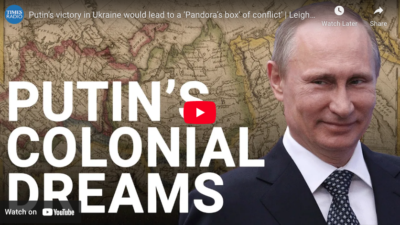Trump-Ukraine: On 14 July 2025 the President threatened major new sanctions against Russia and promised to “massively supply” arms to Ukraine. Is this significant?
Trump-Ukraine: a major statement?
On 14 July, after trailing a “major statement” on Russia, President Trump announced two things:
- the US would impose 100% secondary tariffs targeting Russia’s trade partners if a peace deal was not reached within 50 days (i.e. by roughly 1 September). This would mean massive sanctions on goods from countries that imported Russian oil, to make it harder for Russia to finance its war against Ukraine;
- the US would send “top-of-the-line weapons” to Ukraine through NATO countries.
The question is to what extent this announcement represents a major change of policy from Trump, or whether it is “the same old, same old”.

Donetsk, 2012. Ukrainians would like to return to the peace they enjoyed before Russia’s 2014 invasion
President Trump’s policy on Russia/Ukraine
Since he became US President for the second time in January 2025, Trump has adopted a bafflingly pro-Russian line in the Russia/Ukraine war. In mid-February, US Defense Secretary Hegseth said Ukraine would never regain its pre-2014 borders, or join NATO (links in bold italics are to other posts on this blog). As Former Swedish Prime Minister Carl Bildt commented: ‘It’s certainly an innovative approach to a negotiation to make very major concessions even before they have started.’ The same month, President Trump called President Zelensky of Ukraine a “dictator” – echoing Russian talking points. 28 February saw the slow-motion car crash of Trump’s shouting match with Zelensky in the Oval Office.
Also in February, the United States refused to condemn Russia at the United Nations for invading Ukraine. Instead, the US voted against the resolution alongside Russia, North Korea, Belarus and other authoritarian states. Twice since January, the US has cut off arms to Ukraine, pressuring Kyiv to make concessions and offering Russia a major battlefield advantage. Yet Trump has never put any pressure whatsoever on Russia. It has seemed, so far, as if Putin has had Trump wrapped around his little finger.
Trump-Ukraine: how to end the war
We all want an end to this war. But Russia – unlike Ukraine – has shown no sign of being ready to agree even to a ceasefire. It seems blindingly obvious, therefore, that if President Trump genuinely wants to bring peace to Ukraine, the US needs to put pressure on Russia – the invader. There are two main ways of doing this:
- to impose “secondary sanctions” on Russia – eg tariffs on countries that buy Russian oil. This would handicap Russia’s ability to finance its war against Ukraine, since energy accounts for most Russian exports;
- to provide major, game-changing arms supplies to Ukraine.
At first sight, Trump’s 14 July announcement seems to go some way to satisfying both demands. Or does it?
Sanctions on Russia: Trump statements
President Trump has often expressed frustration with President Putin and promised sanctions. Let’s look at the results.
On 7 March, Trump wrote in a post: “I am strongly considering large scale banking sanctions, sanctions, and tariffs on Russia until a cease fire and FINAL SETTLEMENT AGREEMENT ON PEACE IS REACHED.” Nothing happened.
On 30 March, Trump expressed anger with Putin (he said he was “pissed off” and “disappointed”) and threatened secondary tariffs on countries buying Russian oil if there was no ceasefire deal within a month. Nothing happened.
In April, after meeting President Zelensky at the Pope’s funeral, Trump accused Putin of “tapping him along”. Trump wrote: “It makes me think that maybe he doesn’t want to stop the war, he’s just tapping me along, and has to be dealt with differently, through ’Banking’ or ’Secondary Sanctions?'” Again, nothing happened.
Summary: President Trump has repeatedly threatened new banking or secondary sanctions against Russia. But so far in 2025, nothing has ever happened.
Trump-Ukraine: sanctions: a new page?
On 14 July, Trump said the US would impose 100% secondary sanctions targeting Russia’s trade partners if a peace deal with Ukraine wasn’t reached within 50 days. At first sight, this is a strong move. But in the context of past statements, its significance is unclear:
- the deadline is far in the future – effectively, 1 September. It opens the way to a long summer of Russian aggression – prime fighting season;
- each time President Trump has threatened Russia in the past, President Putin has held a phone call with him, or made a vague statement setting new conditions, and the threats have evaporated. There is not – yet – anything to suggest that the latest deadline is any different;
- for the US to place 100% tariffs on, for example, the main importers of Russian oil would not be easy. Those countries include India, China and other major trading nations. 100% tariffs on them would plunge world trade – and the US economy – into chaos.
So I’m not holding my breath on secondary sanctions and I doubt Putin is, either. My prediction – I hope I’m wrong – is that by late summer Trump will have forgotten all about this, or else Putin will make some conciliatory comments and keep stringing Trump along. No wonder Russian stock markets rose after Trump’s announcement. They feared more concrete action, sooner.
Trump-Ukraine: arms supplies
At first sight, the position on arms looks more promising. Trump has said he will “massively supply Ukraine with what is necessary” through NATO, including sophisticated, desperately-needed, Patriot air defence systems. The Patriot systems are good news. But so far Trump has been vague about what else the US will provide. On 15 July the “Financial Times” reported that on 4 July, in a call with Zelensky, Trump had privately encouraged Ukraine to step up deep strikes on Russian territory. The FT said Trump had even asked whether Ukraine could strike Moscow if the US provided long-range weapons. Quoting people briefed on the call, the FT said Trump described the policy as to “make them [the Russians] feel the pain”, to bring Moscow to the negotiating table.
In response to the reports, Trump said Ukraine should not target Moscow (at around 2.04 on the interview at the link) and appeared to say he was not planning to provide Ukraine with weapons with sufficient range to reach the Russian capital. At the time of writing, then, the impression is that Ukraine will get better defensive weapons; but that this is not a game-changing breakthrough in the war. Again, I hope I’m wrong.
In summary… not a breakthrough
President Trump is nothing if not mercurial. He makes a habit of changing his position regularly in order to unbalance his negotiating opponents. It may be that he will actually do something to put pressure on Russia this time – or could even pull forward his 50-day deadline. But based on experience to date, his announcements on 14 July are not a breakthrough or a radical change from what has gone before.
What to do next
If you are interested in Russia’s war on Ukraine, you may like to look at other Russia/Ukraine posts on this site. My book Lessons in Diplomacy: Politics, Power and Parties also includes a chapter on “How to understand Putin’s war on Ukraine”.

A much-thumbed copy of “Lessons in Diplomacy” in the hands of a student of international relations






